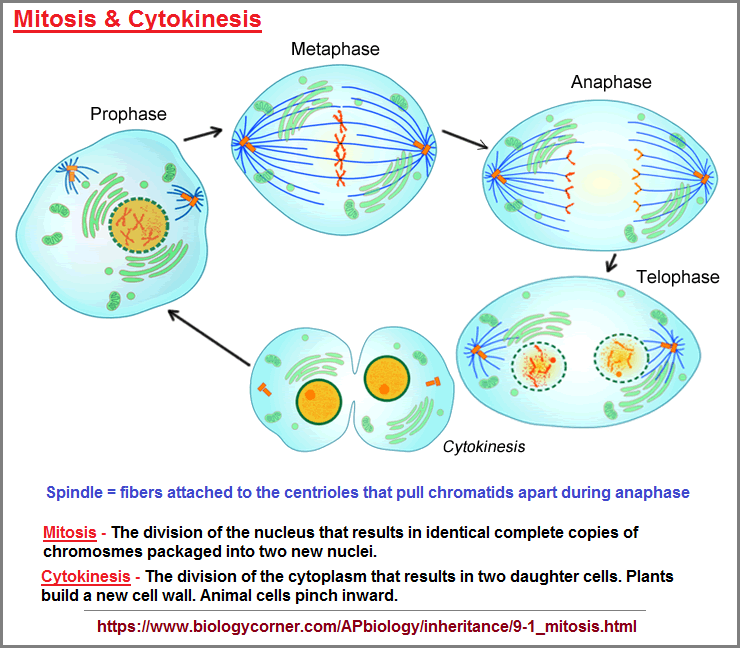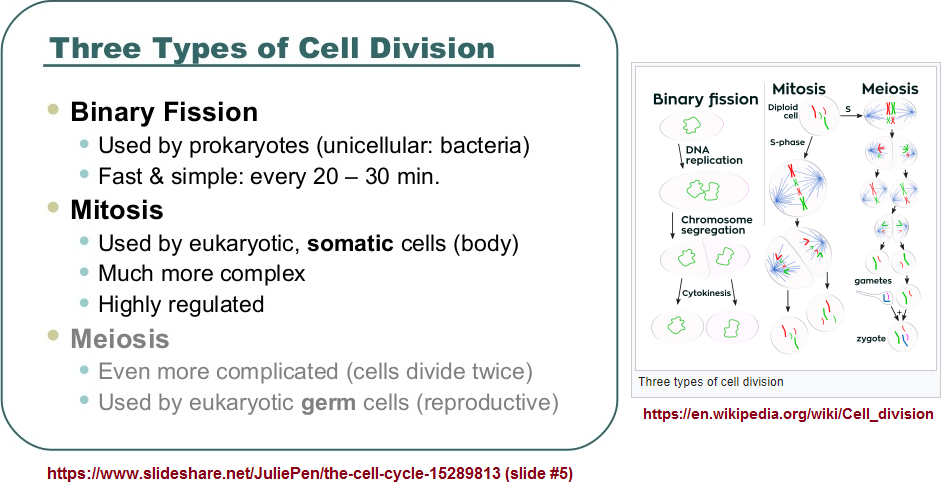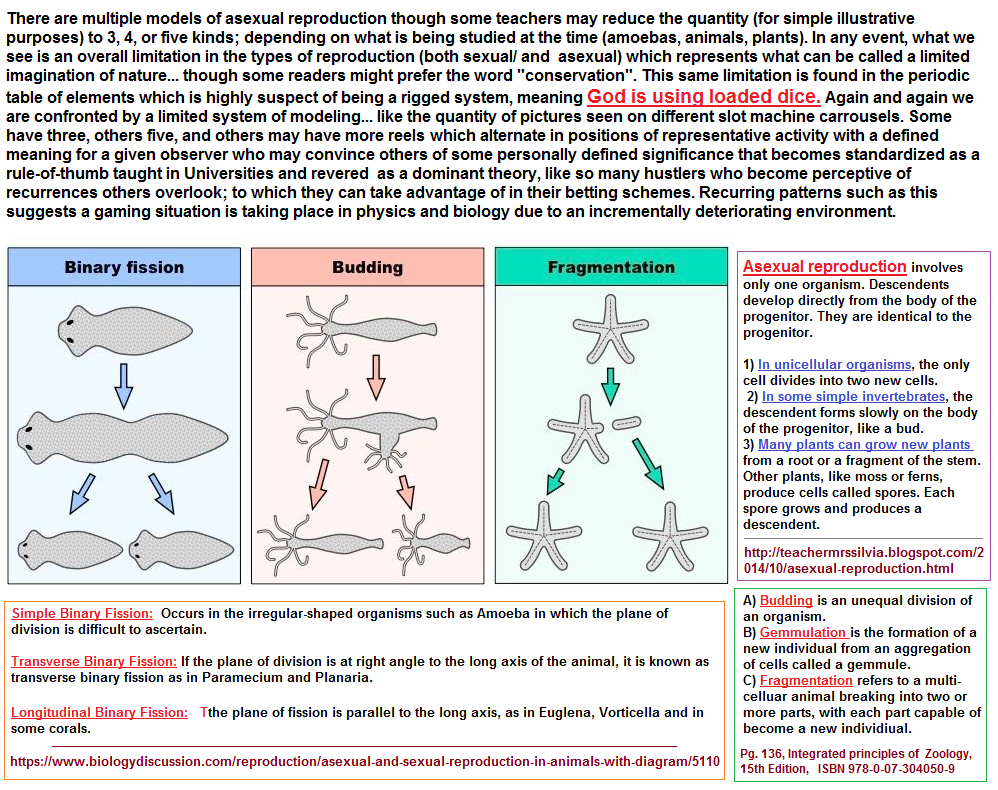page 7
Progressive Thinkers as of 5/8/2020
|
| ||||||||||||||||||||||||||||||||||||||||||||||||||||||||||||||||||||||||||||||||||||||||||||||||||||||||||||||||||||||||||||||||||||||||||||||||||||||
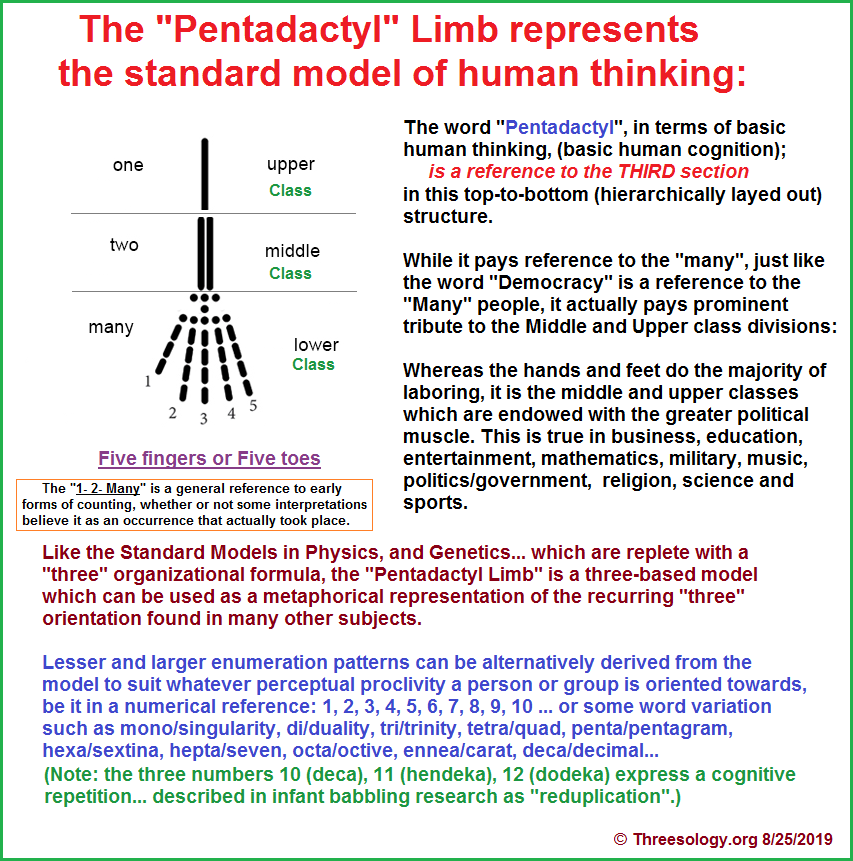
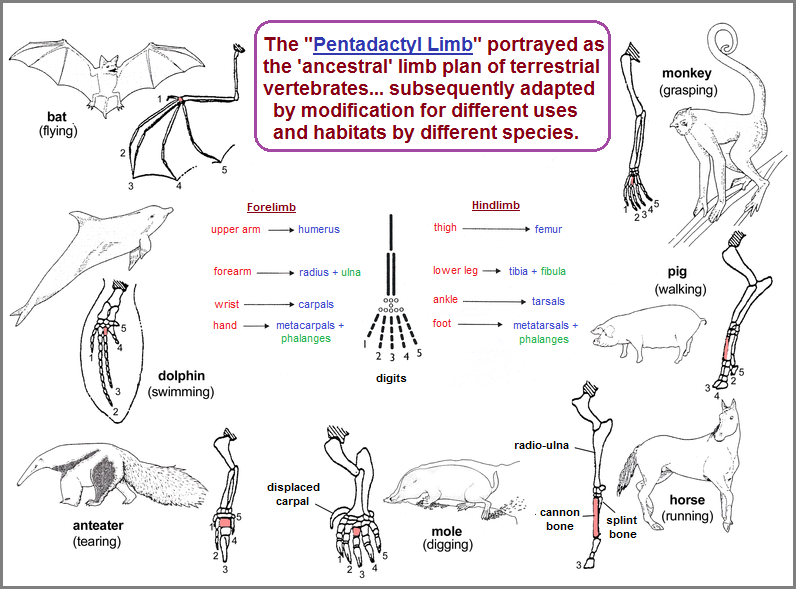
Let us foray into the contemplation of associating atomic particles and companion indices (such as fundamental forces, dark matter, gluons, etc.,) with the Pentadactyl limb. At the outset we notice (by way of visualization) that while the bones can be arranged in a list-like fashion (top to bottom, bottom to top, side to side or diagonally... like moving chess or checker game pieces)— providing an indication of their placement when held together by tendons, muscles, ligaments, veins, arteries, skin, etc... (I say "etc..." in order to provide room for those readers who would like to also consider the psychological domain such that a person does not commonly amputate nor disfigure themselves and therefore is not linked to a previous limb by an invisible force called the phantom limb phenomena.)
In addition, let us come to some semblance of agreement that there is a need for a new language and metaphorical structure in order for us to progress further not only in physics, but mathematics, Anthropology, Chemistry, Astronomy, Archeology, Biology/Genetics, Medicine and every other subject discipline. Necessarily so, with new ideas come new words, or old words with new definitions. While we can use the old ideas of a current subject applied to a non-standard subject in order to gain some incite, as we well notice occurring in the advancement of a subject's orientation and how it is taught and learned, this bottom-up approach can be addressed from a top-down and diagonal direction as well... configured similarly to the moves available to us in chess and checker games.
However, as I survey the repetition of patterns and limitations to which we humans and other creatures are subjected to, the sequences suggest a cyclicity that may represent an encountered loop in what is called the space-time-matter continuum. In other words, this reality, this supposed existence which we call life may be an artefact... an artificiality manifested by a bubble, or a rift in the continuum that is attempting to correct itself. As such, we are traveling at light speed, if not faster, but our perception from within does not provide an accurate vantage point... and those various experiences by some in which they encounter "slowed time" like falling in slow motion, is representative of the actual time-space-matter continuum making adjustments either by way of collapsing the field or venturing towards some so-called "event" horizon which enlarges the bubble as yet another effect of the supposed distortion... where the calm 'eye' of the storm in which we are in is not realized by most... only those who for one reason or another (creativity, genius, sensitivity, etc...) trespass beyond the concentrated norms into some fringe, some outlying interval of experience that may be an intermittent exposure sustained by a greater frequency by some than others... and yet everyone may well experience it at one time or another yet retreat from it or be invigorated... though they may not readily grasp what they are being impressed upon with.
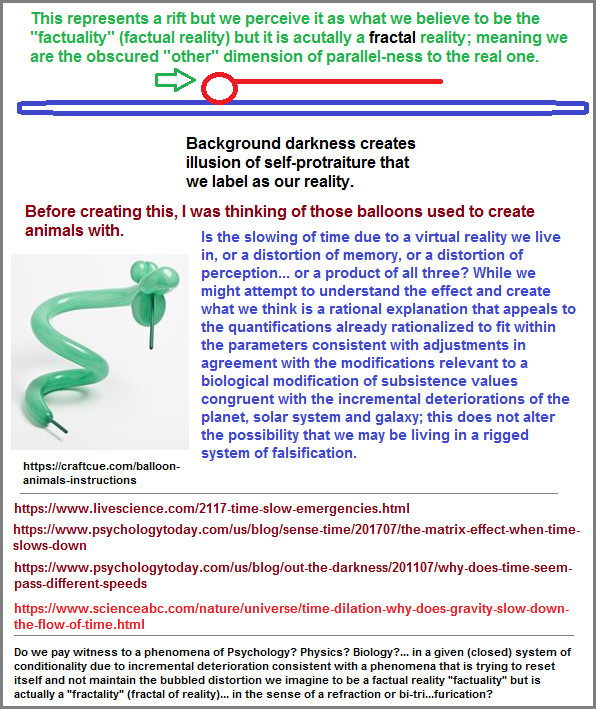
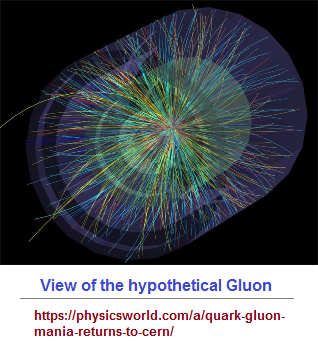
Gluon: an elementary particle that mediates, or carries, the strong, or nuclear, force. In quantum chromodynamics (QCD), the quantum field theory of strong interactions, the interaction of quarks (to form protons, neutrons, and other elementary particles) is described in terms of gluons—so called because they "glue" the quarks together. Gluons are massless, travel at the speed of light, and possess a property called color. Analogous to electric charge in charged particles, color is of three varieties, arbitrarily designated as red, blue, and yellow, and—analogous to positive and negative charges—three anticolor varieties. Quarks change their color as they emit and absorb gluons, and the exchange of gluons maintains proper quark color balance.
Unlike other forces, the force between quarks increases as the distance between the quarks increases. Up to distances about the diameter of a proton, quarks behave as if they were free of one another, a condition called asymptotic freedom. As the quarks move farther apart, the gluons that move between them utilize the energy that they draw from the quark's motion to create more gluons—the larger the number of gluons exchanged among quarks, the stronger the binding force. The gluons thus appear to lock the quarks inside the elementary particles, a condition called confinement. Gluons can also bind with one another to form composite particles called glueballs.
According to QCD, only colorless objects may exist in isolation. Therefore, individual gluons and individual quarks cannot exist in nature, and only indirect evidence of their existence can be detected. In 1979, compelling evidence was found when quarks were shown to emit gluons during studies of particle collisions at the German national high-energy physics laboratory in Hamburg.
Encyclopedia.com: Gluon
 |
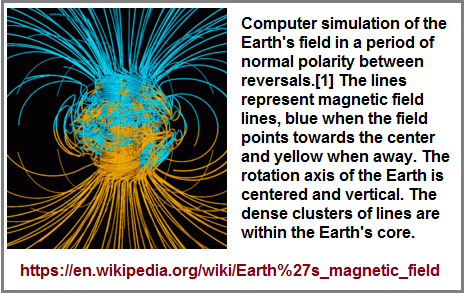 |
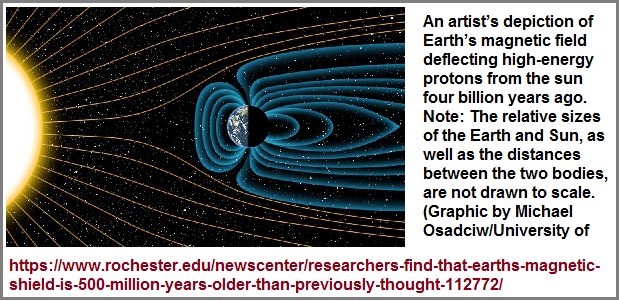 | |
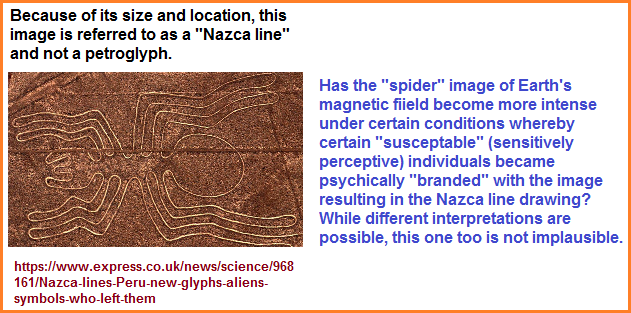 | |
 |
|
Quark: Any one of six particles (although there is increasing evidence of another two) and their antiparticles (antiquarks) that are the constituents of the hadron group of elementary particles. They occur in one of six ‘flavours’: up, down, top, bottom, charmed, and strange. Antiquarks have similar flavours but their charge is opposite that of their corresponding quark. Quarks always exist in combination; free quarks cannot exist. A baryon, such as a proton or neutron, consists of three.
Encyclopedia.com: Quark
Fundamental forces: Four basic forces that exist in physics. The most familiar, and the weakest, is gravitation. The gravitational force between the Earth and an object accounts for the object's weight. Much stronger is the electromagnetic force, which 'binds' particles together. The two other forces operate only on the subatomic level: the weak nuclear force, associated with the decay of particles, is intermediate in strength between the gravitational and electromagnetic force; the strong nuclear force, associated with the 'glue' that holds nuclei together, is the strongest natural force.
Encyclopedia.com: Fundamental force
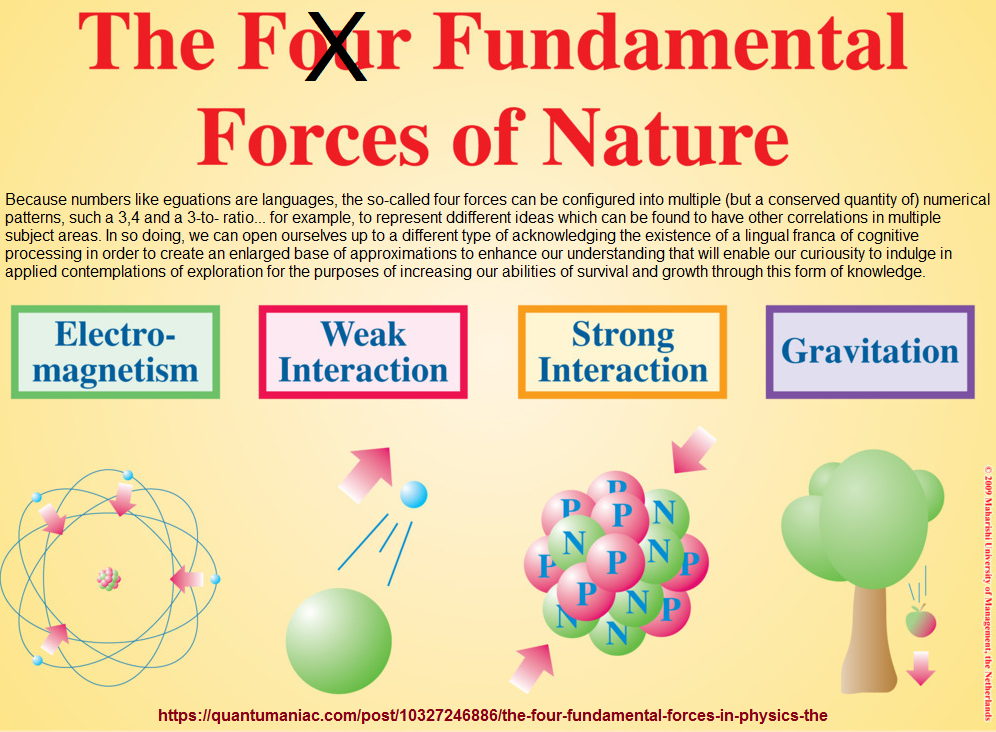
H.O.B. note: While the fundamental "four-ces" are typically quantified as "four", we can break this reference down to a 3-to-1 ratio (such as the weak, strong, and Electromagnetic as a "3" and the Gravitational as a "1". Or we might combine the strong/weak as "1", the Electromagnetic as "1", and the gravitational as "1", to give us an overall "3", though the reader might well indulge in contemplating other configurations. By utilizing other patterns, we open ourselves up to an ability of making correlations with similar patterns found in other subjects for the purposes of drawing our attention to what appears to be ubiquity of design being used by human cognitive processing. In other words, the same patterns are being used across the spectrum of all subjects... suggesting that this conservation of brain activity is being imposed upon on us by what I believe to be an incremental deterioration of the planet, solar system and galaxy. We are being forced into a conservation as a survival mechanism... like those on a raft (named Earth) set adrift on a vast cosmological sea with dwindling provisions and the raft is slowing deteriorating as well, but the people on board have developed three class divisions... the lower class which inhabits the outer edges, the middle class which may or may not transition themselves between the lower and upper class, the upper class which insulates itself from the realities experienced by the lower and middle classes, whereby their central and assumed lofted position in the center of the assumedly deserved lion's share of all resources, whereby their greed and over-indulgence makes them oblivious (out of touch) to the dwindling nature of the provisions because they are in collusion with those who create laws and raise taxes in order to maintain an status quo of their own resource base... even though they may claim otherwise as a political slogan or business by-law ethic... and even though some may honestly be aware of the deterioration, they nonetheless care about their own existence more than the privations which it causes others.
Then again, some have suggested the existence of a Wikipedia- fifth fundamental force:
In physics, there are four observed fundamental forces or interactions that form the basis of all known interactions in nature: gravitational, electromagnetic, strong nuclear, and weak nuclear forces. Some speculative theories have proposed a fifth force to explain various anomalous observations that do not fit existing theories. The characteristics of this fifth force depend on the theory being advanced. Many postulate a force roughly the strength of gravity (i.e. it is much weaker than electromagnetism or the nuclear forces) with a range of anywhere from less than a millimeter to cosmological scales. Another proposal is a new weak force mediated by W' and Z' bosons.
The search for a fifth force has increased in recent decades due to two discoveries in cosmology which are not explained by current theories. It has been discovered that most of the mass of the universe is accounted for by an unknown form of matter called dark matter. Most physicists believe that dark matter consists of new, undiscovered subatomic particles,[1] but some believe that it could be related to an unknown fundamental force. Second, it has also recently been discovered that the expansion of the universe is accelerating, which has been attributed to a form of energy called dark energy. Some physicists speculate that a form of dark energy called quintessence could be a fifth force.
A fifth fundamental force could really exist, but we haven't found it yet by Brian Koberlein, Universe Today, Nov. 27, 2019
In viewing the above image of the gluon interacting between two particles, I can not help to review those image in my mind which represent the visualized images of "gluon" taking place in human cell division, though similar "strings" or lines or fivers of inter-connectivity might well be envisioned taking place between or as part of some types of cells.
The spindle fibers can be seen as a "gluon" force. In addition, we might also look upon the condition of hair or fur on humans and animals as a primitive representation of a gluon-like remnant. In other words, the multiplicity of hair, of legs on a centipede, of tortoise eggs, of feathers, of cell growth and death, etc., as all models of that akin to a gluon-like expression governing multiple considerations and not just that seen in particle physics on the atomic level. Macroscopic reflections of microscopic and atomic level events may be extant in different forms and formulas.
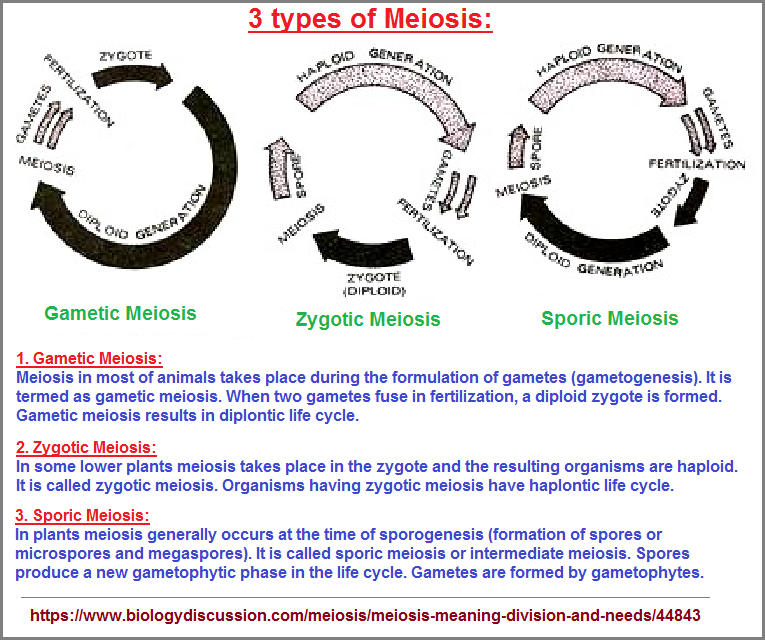
Three types of cells in the body that undergo mitosis: Somatic cells, adult stem cells, and the cells in the embryo: What Type of Cells Undergo Mitosis by Lakna, March 30, 2018.
When speaking of biology in the context of identifying the number values being displayed in different models, a look at asexual reproduction can be correlated with physics because both appear to represent a multiplicity in closed systems with internalized patterns that separate researchers (observers) may focus on and quantify individualized events for personal interests. In other words, different subjects develop into sub-divisions because particular aspects are studied more intensively than other aspects or what is presumed to be larger domain of a given subject. While there are multiple types of asexual reproduction just like there are multiple types of particles, there is an overall limitation not only in the subject material, but how we humans are perceiving the types and come to display them in models. All models appear to represent an underlying quantity and this quantity is limited. In many cases of the limitation, a given researcher may use such terms as major, minor, greater, lesser, more, etc., which, when used in an internet search phrase such as "the principle forms of asexual reproduction" (where the word "principle" can be replaced by other words (major, most common, standard, greatest, etc...) or applied with a number such as "the 3 principle forms of asexual reproduction"), we find that different representative ideas may be provided, while some ideas may be provided over and over again regardless of how the search criteria is formulated in most cases. Nonetheless, we are dealing with a recurrence of limited values not only in human behavior but the existing behavior of biology and physics.
While some readers no doubt already engage in a personalized intellectualism of noting numbers and equations as a language that can be improved upon, the privacy of their thoughts may not be discussed with even their closest associates with whom they are in competition with for some academic, monetary or other reward. Hence, we are left to our own devices.
All our theories, all our beliefs, can thus be looked upon as rationalizations representing survival efforts under incrementally deteriorating conditions that force us to modify our ideas and behavior as adaptations whose accustomization is otherwise labeled as tradition, common sense, law, rule-of-thumb and the like.
However, when we look upon the apparent correlative circumstance with respect to particles... the tendons, muscles, ligaments, etc., are labeled like some antiquated mysticism from the deep past when such terms as "gluons" and "fundamental forces" are used... though all the language being employed in present descriptions of particles and their activities as well as structure is highly suspect as well. Such a language no doubt adds to the stagnation we presently see in physics research because it is much like a convoluted menagerie of allusions, suppositions, fairytales, conjectures, adolescent slang, sign language and tripped-up metaphors and the like. They reek of a time in which words or notions such as the following (and others) were used as explanations of ideas dealing with phenomena that was not well understood.
- Ectoplasm
- Psychic-al
- Elixir vitae, ("elixir of life"), [Chinese Taoists: "pill of immortality":{elixir." Encyclopædia Britannica}]
- Four humors: blood, yellow bile, black bile, and phlegm
- Vitalism (vital force)
- Phlogiston: (5th element proposed by Johann Joachim Becher to go along with the four classical elements of (Earth, Water, Air, Fire) which was contained within objects that could burn: 10 Debunked Scientific Beliefs Of The Past by Jamie Frater, Jan. 19, 2009
- Aether: once thought to be the medium which light propagated through.
- From Crystallography: it was once thought that crystalline solids could only be composed of repeating blocks (unit cells) that could be used to tile all of space.
- BCS limit (Bardeen-Cooper-Schrieffer theory) in which in which superconductivity is caused by electrons interacting with atomic lattice vibrations) could only have a maximum transition temperature (Tc) up to 30–40K. (These Scientific Theories Were Accepted Once, But Were Later Proven Wrong)
- Preformationism: little man in sperm. See also: (Epigenesis and Preformationism)
- Phrenology: the study of the conformation of the skull as indicative of mental faculties and traits of character: (Britannica: Phrenology)
- Piltdown man hoax: Britannica: Piltdown man
- 10 Anthropological Hoaxes And Fake Civilizations by Debra Kelly, July 17, 2015
- Margaret Mead and the Great Samoan Nurture Hoax by Christopher Badcock Ph.D., Feb 07, 2017
- The Depressingly Fake Mysteries of America's Stonehenge by Jason Colavito, 1/15/2013
- Craniometry: is measurement of the cranium (the main part of the skull), usually the human cranium. It is a subset of cephalometry, measurement of the head, which in humans is a subset of anthropometry, measurement of the human body. It is distinct from phrenology, the pseudoscience that tried to link personality and character to head shape, and physiognomy, which tried the same for facial features. However, these fields have all claimed the ability to predict traits or intelligence. They were once intensively practiced in anthropology, in particular in physical anthropology in the 19th and the first part of the 20th century. Theories attempting to scientifically justify the segregation of society based on race became popular at this time... (Wikipedia: Craniometry)
- etc...
Nonetheless, words and notions like gluons and fundamental forces is what we have at the present and must use them, despite how they may be laughed at by future generations for indulging in such silly representations... We will use them at least for the time being, until physics moves past its present age of superstition and infantile grasp of a sober reality. We are like a primitive who has never seen a wheel or fire before and attempts to understand as well as make usage of them. This is the present state of all subjects... we are merely at the threshold, though some have been courageous enough to take a step or two past the doorway. And for those who would want to argue otherwise, claiming that we know a lot... for example in medicine and physiology as well as architecture and biology; so does a child familiar with tinker toys and the whereabouts of their toys in a given territory of their fenced-in backyard. We create fences and ceremonially create systems to offer college degrees to others to intellectually devise a trail inside a given parameter where subject-specific toys of interest are laid out in a given order according to a set standard that may or may not be individually arranged in order to better assist in a person's personal understanding and recitation in order to give some measure of suggesting to others that they "know" a subject's materials and are therefore an informed expert in addressing the presence of a given situation with the language of their given subject in comparison to their respective toys and their operational directives (functional fixedness). Yet, it is not too un-often that we encounter someone who knows a given subject but if you attempt to lead them to far from the confines of this parameter, they become conformably lost in their attempts to associate their ideas with the similarity of those in other subjects, much less those ideas configured by overlappings of multiple other ideas in terms of suppositions or related functionality using different labels.
If we continue with the analogy that the fundamental forces and gluons are synonymous (so-to-speak) with ligaments, tendons, muscles, etc., then we are confronted with the idea that such fundamental forces and gluons are not static ("always present in the same form and functionality"), but are dynamic (transitive/moving) in terms of a cyclical development that is vulnerable to changes just like tendons, ligaments, muscles, etc., are vulnerable to disease, injury and genetic malformation or a genetic transformation which exceeds commonality. In this sense, the fundamental forces and gluons may have a standard form of regeneration, but that we might well encounter moments, periods, etc., when a physicist observes a non-standard expression of a fundamental force or gluon. Indeed, this may be the case for all particles— where there is a standard developmental regenerative pattern, but exceptions do occur and may not be isolated events. In other words, a biological metaphor for understanding atomic particles can be helpful like a tool by which they can be translated, which means we may be looking at a three-patterned assortment of languages/writing systems presently being used by particle physics who think they are speaking only one because of their adopted work place vernacular that they have grown accustomed to and do not consciously appreciate that the language they are speaking in as a conglomeration... an adopted lingua franca. In fact, they may occur as a standard model in their own right in given instances like an isolated tribe of people with their own mannerisms and cultural orientations.

A lingua franca also known as a bridge language, common language, trade language, auxiliary language, vehicular language, or link language, is a language or dialect systematically used to make communication possible between groups of people who do not share a native language or dialect, particularly when it is a third language that is distinct from both of the speakers' native languages.
Lingua francas have developed around the world throughout human history, sometimes for commercial reasons (so-called "trade languages" facilitated trade), but also for cultural, religious, diplomatic and administrative convenience, and as a means of exchanging information between scientists and other scholars of different nationalities. The term is taken from the medieval Mediterranean Lingua Franca, a Romance-based pidgin language used (especially by traders and seamen) as a lingua franca in the Mediterranean Basin from the 11th to the 19th century. A world language – a language spoken internationally and by many people – is a language that may function as a global lingua franca.
Here are some other "trade languages" variations:
- Why Workplace Jargon Is A Big Problem by Maddie Crum, Updated Apr 25, 2014
- A vernacular, or vernacular language, is the speech variety used in everyday life by the general population in a geographical or social territory. The vernacular is contrasted with higher-prestige forms of language, such as national, literary, liturgical or scientific idiom, or a lingua franca, used to facilitate communication across a large area. The vernacular is usually native, normally spoken informally rather than written, and seen as of lower status than more codified forms. It may vary from more prestigious speech varieties in different ways, in that the vernacular can be a distinct stylistic register, a regional dialect, a sociolect, or an independent language. According to another definition, a vernacular is a language that has not developed a standard variety, undergone codification, or established a literary tradition.[2][3] In the context of language standardization, the terms "vernacular" and "vernacular dialect" are also used as alternative designations for "non-standard dialect".
- Social Dialect or Sociolect Definition and Examples (gender, social class, age, ethnicity, religious affiliation; LOL-Speak, Slang...)
With a standardized language represented by a standardized list of words and phrases, comes standardized ideas. Mathematics is problematic because it is clearly a form of art expression. It is a metaphor stripped down to a nakedness that is dressed and colored by the interests of the mathematician who place the figure of an equation into the scenery of a context. It is so problematic due to a human ego which has been adopted by motion picture script writers in which they have a character describing human-based mathematics as a Universal language that intelligent aliens visiting or listening to humans on Earth will necessarily choose it as the basic method of communication. Humans are so arrogant they think of themselves as being supremely intelligent by comparing themselves to other forms of life and not other sentient beings who might well view humans as village idiots, if not acting like chickens with their heads cut off or even some lowly life form like a worm or mindless insect whose life span is one of chemically induced impulses and interactions.
| You're in touch with the world that impinges on you, Can you make any sense of this terrible brew? You'd extract what is beautiful and what is good, Or you gaze at the mess and just wish that you could! If you have seized some good from this fast whirling brew, You might then want to know if it's false or if true; You'll transform what you've caught so that all understand, Thus conveying your thoughts through the use of your hand. This is where the artistic creation begins, Creatures might have no legs or the fish have no fins, What the brush puts on canvas has been through the fire, "Let us get to the meaning!", we shall all inquire. From the crucible of such creations' wild act Comes a language that does not describe any fact! Mental states are thus formed in recipients' minds So that each one a meaning quite readily finds. Zoltan P. Dienes, Jan. 2004 Mathematics as an Art form. |
Date of Origination: Monday, 25th May 2020... 4:33 AM
Date of Initial Posting: Thursday 18th June 2020... 10:25 AM
